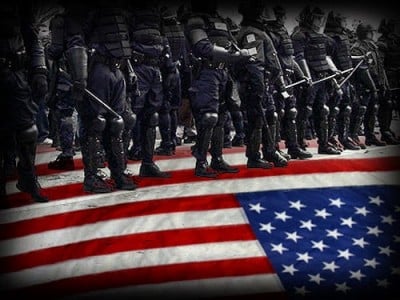Report Finds FBI Undercounts Police Killings by Half

Even before the BJS study, the FBI’s annual statistics of “justifiable homicides” were widely known to be a significant undercount. A list compiled on the website Killed by Police of every police killing mentioned in the American media includes more than 2,000 deaths since May 2013.
The BJS study found that, on average, police killed 928 people per year between 2003-2009 and 2011, almost two and a half times higher than the FBI figure of 383. A total of 2,103 killings went unacknowledged by the FBI during that period.
The FBI’s figures are based on voluntary reporting by local police agencies, with no standard reporting methodology, and are “estimated to cover 46 percent of officer-involved homicides at best,” according to the report. This is despite the fact that regular annual reports to the federal government on police brutality statistics has been legally required since the 1994 passage of the Violent Crime Control and Law Enforcement Act.
Every year, many states do not report any figures to the federal government at all. In 2009, for example, only 42 states sent reports. The eight states plus the District of Columbia that did not had a combined population of over 30 million as of the 2010 Census.
Even the wildly inaccurate FBI figures, however, cannot conceal the explosive growth of police violence. Last November, it was reported that 2013, the last year for which FBI statistics are available, saw the highest level of police killings on record, while the number of police killed on duty dropped to its lowest level in decades. Since that time, nearly 300 additional people have been killed by law enforcement.
Unarmed man shot in face, killed by Florida SWAT officer during drug arrest
Twenty-six-year-old Derek Cruice was fatally shot in the face early Wednesday morning by a Florida SWAT officer working during a drug arrest at his home in Deltona, northeast of Orlando.
A statement from the Volusia County Sheriff’s office claimed that Cruice “advanced” on officer Todd Raible, who was there as part of a narcotics team, as he entered the doorway, “[causing] the deputy to perceive a threat.” He fired once at Cruice, hitting him in the face, who was later pronounced dead at a local hospital. The sheriff’s department admits that Cruice was unarmed.
Five of Cruice’s friends were in the house at the time of the shooting. They have denounced the sheriff’s version of events, calling the shooting “murder.” One of Cruice’s friends, speaking anonymously to the media, said, “[The sheriff’s statement] is completely a lie. I was there; I watched the whole thing. There was no advancement. There was no reaching for anything.”
Twenty-four-year old Matthew Grody, another of Cruice’s friends, also denied that he had resisted. Grody told a local police station, “There’s a couple of seconds between opening the door, walking out, getting to my knee, and halfway out there’s gunfire. I look back as the guy’s grabbing me, and my friend is dead or dying.” Grody said that Cruice was only wearing shorts at the time of the shooting, and could not have been assumed to be carrying a weapon. “The guy was wearing basketball shorts like I am. It’s kind of hard to conceal anything or hide anything when this is all you have on,” said Cochran.
Police claim to have found only approximately 7.5 ounces of marijuana at Cruice’s home, which nevertheless is considered a third-degree felony in Florida, punishable by up to five years in prison and a $5,000 fine. Florida’s marijuana laws are considered to be among the harshest in the country.
Police in Grapevine, Texas, refuse to release dashcam video from police killing of Mexican immigrant
Police in Grapevine, Texas, a suburb between Dallas and Fort Worth, suddenly reversed course this week, declaring that they will not release dashcam footage from a police shooting of a Mexican immigrant as promised in late February.
On February 20, Grapevine police officer Robert Clark shot and killed, 31-year-old Ruben García Villalpando on the service road of a state highway during a routine traffic stop. Police have admitted that García was unarmed and had his hands up when he was shot, arguing only that he ignored Clark’s orders to stop walking towards him. García’s brother-in-law says that one of his last words before being shot was “Are you going to kill me?”
“They do not want us to release that video due to the fact that it’s evidence in a criminal investigation,” a police spokesman told the media. The district attorney’s office justified the about-face by claiming, “Due process requires that evidence not be released to the public while an investigation is ongoing.”
The killing has sparked widespread outrage throughout the area, which is home to a large and impoverished immigrant community. On Wednesday, more than 200 people demonstrated at a Grapevine city council meeting, chanting, “Hands up don’t shoot” and “Are you going to kill me?”
Louisiana sheriff unleashes vicious tirade against teenage victim of police beating
Newell Normand, the sheriff of Jefferson Parish, which is adjacent to New Orleans, called a press conference Wednesday in which he issued thinly veiled threats of physical violence against a 17-year-old who was badly beaten by an undercover deputy after leaving a Mardi Gras parade.
Cell phone video footage uploaded to YouTube by one of Brady Becker’s friends shows detective Nicholas Breaux choking Becker and pinning him against the floor of a mall parking lot, before unleashing four punches to Becker’s head, fracturing his jaw and giving him two black eyes. The video shows Becker attempting to protect himself by pushing off against Breaux’s chest. That Becker’s hands are extended near Breaux’s neck has been twisted by Normand into Becker supposedly being the one choking Breaux. Becker was later charged with possession of alcohol by a minor, resisting an officer, battery of a police officer and inciting a riot.
At the press conference, Normand angrily accused Becker of picking the fight and attempting to “bamboozle the public.” He then offered suggestions for how to properly administer such beatings in the future:
“[I’m not] so sure I would have struck him with my fist, for fear of breaking my hand. But I’d have definitely kneed him in the groin. I’d have kneed him in the stomach. I’d have tried to knock his wind out, because he does not have the legal right or authority to grab my officer. That is not what we’re paid for.”Normand then showed the assembled reporters what he claimed to be a second cell phone video that he says shows a witness reaching for one of the deputy’s weapons and proving that Becker started the fight. Reporters were only allowed to view the video once after turning off their recording equipment. The New Orleans Advocate declined to describe the video in its report of the press conference, noting that “it was difficult to discern what the new video depicts.”




No comments:
Post a Comment